Home » Posts tagged 'ready nutrition' (Page 12)
Tag Archives: ready nutrition
12 Tips to Pack Your Bug-Out Vehicle Like a Pro
12 Tips to Pack Your Bug-Out Vehicle Like a Pro
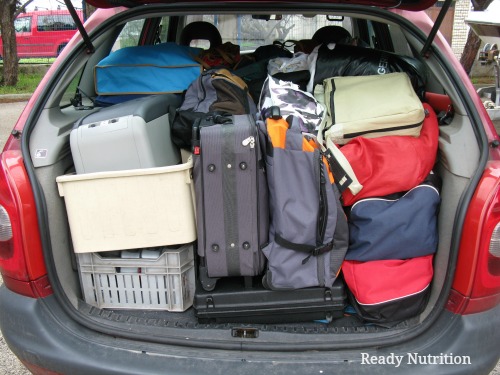
Well, we’re going to cover the vehicle loads in this article and follow up with one on backpacks and rucksacks in Part 2. So, let’s jump into it! One of the things that you must find out first regarding your particular vehicle is its load capacity. How much weight can it hold? How much can the axles take? It is more than this, however: certain weight loads will shift with terrain and with the gradient driving upon. A steep incline that tilts the bed of that pickup too far will end up turning that pickup into a dump truck.
In addition, you also need to assess what you’re transporting to minimize danger. Ammo, flammable liquids, and so forth. An accident with a power line can introduce electricity into the equation and create a secondary explosion that ends up being worse than the accident. Let’s go through some basics.
- Strap down all your loads as best you can…and make this mandatory with anything that is liquid/fluids, such as water cans, fuel cans, etc.
- Make sure all your flammable liquids are in sealed and sturdy containers that do not leak and can hold up to rough handling.
…click on the above link to read the rest of the article…
Operational Essential Task Lists for When the “S” Hits the Fan
Operational Essential Task Lists for When the “S” Hits the Fan

Try and understand that this list can be changed and modified to fit the needs of a family and their idiosyncrasies. Each family is different and unique in terms of physical conditioning, skill-sets, geographic location, and family demographics, there will be different challenges facing each family even in the same disaster.
These are tasks that all the family members…the ones able physically, mentally, and chronologically…should be proficient in. Let’s do it!
- First Aid: Everyone in the family should learn about bandaging and splinting (termed “sticks and rags” in the Army). How to dress a wound, run a simple set of sutures, clear and maintain an airway, perform CPR, treat for heat and cold weather injuries. About a year ago, we did a series on Field First Aid that you may wish to refer to for a refresher on these tasks. Also: if you have any family members who have special medical needs…all the rest of your family needs to know how to take care of them…from injections to the administration of oxygen.
- Essential Outdoor Survival Skills: Building a Fire, Disinfecting/Treating Water, Construct a Lean-to or Erecting a Tent, Cleaning and Cooking Wild game, fowl, or fish. These are some of the tasks. Depending on your geographic locale and the season of the year, there may be a substantial number of tasks added that require proficiency.
…click on the above link to read the rest of the article…
Essential Skills, Tasks, and Training for Preppers and Survivalists: Part 1
Essential Skills, Tasks, and Training for Preppers and Survivalists: Part 1
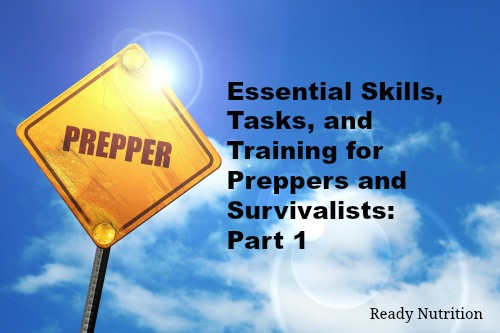
What is your focus? What type of work do you do? How do you allocate your time? A short time ago, I wrote a piece on the importance of self-analysis: creating a true picture of yourself, your strengths, and areas that you need to improve in. This holds true here, as you identify and prioritize your goals, with an overall objective in mind. Here is an overall objective for you:
To survive and thrive as you and your family develop physically, mentally, and spiritually to well-round yourselves and prepare for any disaster that arises.
Simple enough. The Mission-Essential Task List for Training can become a big part in actually realizing that objective and maintaining it. This METL (called “Metal” in the Army) for your use will use broad categories to train and prepare that you can refine as your needs change and your skills improve. Let’s start it off!
- Physical Training: It all starts here, with whatever you do to be able to “hang with the big dogs!” Whether you’re a Triathlete, a weightlifter, a boxer, or a swimmer, you need to take your personal forte and tailor it to the maximum productive capacity. Outline your training schedule, plan short and long-term goals for improvement, and take copious notes!
…click on the above link to read the rest of the article…
When a Zippo Is Not Enough, These Fire Starting Materials Could Be a Lifesaver
When a Zippo Is Not Enough, These Fire Starting Materials Could Be a Lifesaver

There are several types of stormproof and windproof matches. The company I recommend for them are UCO windproof and waterproof matches. You can purchase these at Cabela’s or you can visit the site at UCO gear.
These guys deliver, and they come within a case that keeps them waterproof (even though they can be submerged under water and then struck on virtually any surface). At $5 to $7 they’re a good investment. Strike anywhere matches can be waterproofed, however, they are hygroscopic, meaning they absorb moisture/humidity/water with time.
Along with matches, you’ll need a good lighter. Everyone is familiar with the Zippo, that works on white gas/Coleman fuel, as well as gasoline. They are good to have for a backup when the times are tough, and butane is in short supply. The drawbacks lie in the fact that they leak, meaning the lighter doesn’t stay closed and loses/evaporates its fuel. Also, you need flints and wicks with them.
For disposables, I really like the ones made by Djeep, a French firm. They are short, rectangular, and stubby, and they both take a beating and are dependable. It can’t hurt to pick up a few dozen of them.
…click on the above link to read the rest of the article…
If You Don’t Know the Answers to These Questions, You Need to Work on Your Prepper Mindset
If You Don’t Know the Answers to These Questions, You Need to Work on Your Prepper Mindset

Do you know yourself? It is a fair question. Survivalist and prepper, yes, but do you reallyknow yourself? One of the problems that we face in life is that we find our identity, the “who we are” within our interests…of what we do. If a guy works with electrical outlets and wiring buildings, then he is an electrician and calls himself as such. Akin to the zombies in George Romero’s movie, “Night of the Living Dead,” we plod through life and live and die within our professions, perhaps changing from one profession to another, but always self-identifying with what we do: a utilitarian identity.
But who are we? Do we know ourselves?
Perhaps this is confusing; however, rather than leave you with the question to sort out, let’s place some feedback and framework into it. Let’s answer a question by asking ourselves more questions. YOU SHOULD WRITE THESE DOWN ON PAPER, to review. Let’s do it!
…click on the above link to read the rest of the article…
How Natural Aids Can Lessen Your Chance of Contracting the Pneumonic Plague
How Natural Aids Can Lessen Your Chance of Contracting the Pneumonic Plague

The thing with this “offshoot” of the plague is that it can be transmitted just by sneezing on someone. Airborne transmission is occurring, where droplets from the infected individual’s coughs, sneezes, and mucous fluids carry the bacteria and spread it. If a person sneezes on the wall, and later another person touches that wall with their hand? Such contact can transmit this pneumonic plague.
In the previous article, we covered some standard pharmacological treatments for this pneumonic plague. Now we’re going to over some herbal supplements you may wish to stock up on. Why? Well, if the plague goes out of control and there’s a shortage of pharmaceutical medications, that is one reason. Another is that if the S hits the fan, the plague will increase both in severity and in the geographic locale. It will spread. The symptoms of pneumonic plague are increased body temperature/fever, weakness, and severe headache, as well as coughing and sneezing. The symptoms usually manifest within 1 to 6 days from the time the person has been infected.
The best medicine is preventative medicine.
Garlic
…click on the above link to read the rest of the article…
A Prepper’s Guide to Cold Weather Gear: 10 Must-Haves to Stay Warm in the Harshest of Conditions
A Prepper’s Guide to Cold Weather Gear: 10 Must-Haves to Stay Warm in the Harshest of Conditions
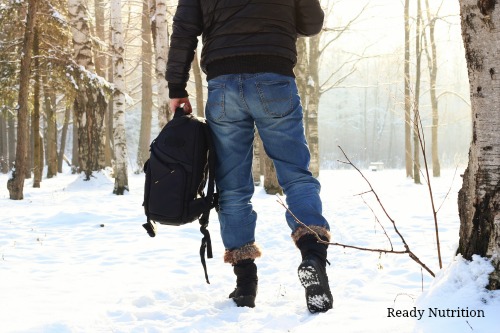
Read The Green Beret’s Winter Survival Training Guide for more information on surviving in extreme weather conditions.
A Prepper’s Guide to Cold Weather Gear
Let’s cover some of the important concepts of gearing up for the Fall and winter.
Proper sleeping bag: remember to switch off those lighter summer bags for a winter-weather/extreme cold weather sleeping bag, preferably with a Gore-Tex cover. Don’t forget a good, reliable ground pad to rest on…remembering the importance in preventing conduction (the passage of body heat into the ground, and cold from the ground into the body).
Gore-Tex “Monster”: That’s right! Become the Gore-Tex Monster! You need a good Gore-Tex top and pants to protect you from the cold and the moisture. Gore-Tex breathes and it is reliable. They have Gore-Tex jackets too. Just remember not to lean too close to the stove or the fire and melt it. Read more on what to wear in the harshest of environments.
Footgear/Thermals/Socks: All of these are vital to winter weather preparedness. Make sure that you pack heavy socks and have at least one change of each packed in a waterproof bag and stuffed in your pack. Read more about protecting your feet and how important it is.
…click on the above link to read the rest of the article…
Health Alert: Fatal Airborne Transmission of Pneumonic Plague Spreading at Alarming Rate. These Lifesaving Antibiotics are Your Best Defense
Health Alert: Fatal Airborne Transmission of Pneumonic Plague Spreading at Alarming Rate. These Lifesaving Antibiotics are Your Best Defense
[Editor’s Note: Have you noticed how deadly outbreaks have been occurring more frequently? Remember the Ebola scare? Or the avian flu epidemic? While many of these spread in third world countries, they are escalating in severity. Mother Nature may be telling us something.
Presently, the pneumonic plague or as many of us know as The Black Death has resurfaced and it’s airborne. Thus far, 684 plague cases and 57 deaths have occurred from an airborne transmission of the plague in Madagascar and Seychelles. One fact is certain, this outbreak is spreading at an alarming rate and many in the affected area are scrambling for face masks, supplies and most importantly, antibiotics.
Only time will tell if this outbreak moves to other parts of the world, but it is important to keep a vigilant eye on this health crisis and know how to protect yourself to mitigate the effects.]
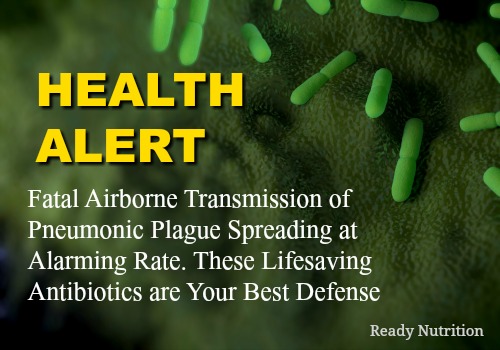
Dave Hodges released an excellent piece recently, entitled “Something Very Big and Very Evil is About to Happen” that is worth reading, especially concerning the special warehouse facilities where government medicine and supplies are being stockpiled throughout the nation. Another very relevant article is entitled “An alarming development as the Bubonic Plague is now confirmed in the Seychelles while hundreds of new cases suspected in Madagascar“. The reason this plague is so bad is that it is readily transmissible, it is a pneumonic plague (which is more severe), and fatalities are occurring within 24 hours.
…click on the above link to read the rest of the article…
Fact: Your Chances of Surviving a Post-Collapse Urban Environment are Slim
Fact: Your Chances of Surviving a Post-Collapse Urban Environment are Slim
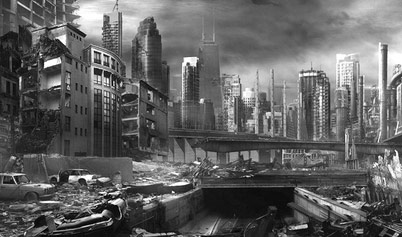
So, we have our collapse. Let us “X” out a nuclear war/nuclear terrorist attack, as we can deal with all the other scenarios in variables without radiation to contend with. Let’s identify the largest challenges faced for that high-rise apartment resident in Manhattan, or the family in the brownstone on the South side of Chicago. First, let’s game the scenario:
After “The Day,” the city was almost completely without power. You and your wife and two children were not able to leave town. All mass transit was halted or discontinued. It has been three days, and your family has been listening to static on the radio for the most part, with “campy” pre-recorded disaster broadcasts that have not been helpful or informative. One of your neighbors left this morning after saying goodbye: he and his family had a boat, and they were heading out of the harbor, hoping to use one of the major rivers to make an escape.
They didn’t have room to take you or yours, but you wanted to stay put and not follow your neighbor’s idea: that there were plenty of boats whose owners were not going to use them…probably dead following the rioting and civil breakdown. You’re beginning to think you should have listened to him. Now you can hear angry voices outside, and you go to the window. A mob has gathered at the top of your street!
…click on the above link to read the rest of the article…
A Crash Course in Preparedness – Week 2 – Medicine, Sanitation, and Surviving Disaster Diseases
A Crash Course in Preparedness – Week 2 – Medicine, Sanitation, and Surviving Disaster Diseases
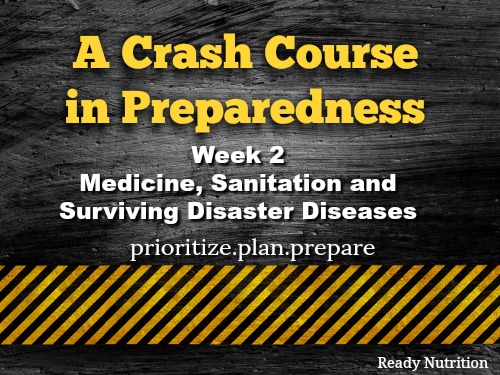
Welcome back to week 2 in our Crash Course into Preparedness. Last week we discussed the basics of survival and gear needed for a short-lived event. One of the comments from last week’s class mentioned that it isn’t hard to prepare, you just have to start. I couldn’t agree more! My only addition I would make to this comment is in order to start you must prioritize your needs and know what you’re planning for. This week, we are taking the same concept from last week – prioritizing, planning and preparing to another facet of disaster planning and highlighting the more dirty side of preparedness – medical and sanitation needs.
Some of the greatest threats in an emergency occur after the disaster. Lack of accessible clean water following major disasters can quickly escalate and create secondary problems in a post SHTF situation. Additionally, those unsanitary conditions can exacerbate the spreading of diseases, infections and health risks. In this preparedness course, we will cover the most common issues that occur following a disaster that relates to hygiene, sanitary and medical condition.
Sanitation, good hygiene, and medical preparedness all go hand-in-hand. But as you will see after reading this guide, it takes a lot of planning and a lot of preparation. Simply put, there are many wrong turns a person could take in the aftermath of a storm and their health could suffer as a result. Therefore it is paramount that you understand the magnitude of these types of disasters and how to avoid them. As Ready Nutrition writer, Jeremiah Johnson noted in a recent article, “hygiene protects you from germs and diseases, as well as preventing the body from falling apart.” In the aftermath of disasters, this needs to stay at the forefront of our priorities.
…click on the above link to read the rest of the article…
When The Grid Goes Down…
When The Grid Goes Down…
Let’s just say that the unthinkable becomes the real and happening. Let’s take this article and go over it. This will be a segment in three parts, the next ones being immediate actions taken at work and at home. I’m hitting on traveling first, as there are so many vacationers jaunting around happily over the landscape. All kidding aside, traffic is congested during the summer, extending traveling time on the commutes. Let’s game the scenario, and here it is.
Here’s the scenario:
You’re cruising down the highway in your 2013 four-door sedan, having just dropped the kids off twenty minutes ago to the swim club. Now you’re on the open highway with a heavy traffic flow…about 5 miles from the edge of town and 7 miles from work. You’re listening to the radio, when suddenly it crackles and goes dead, along with your engine. You look around and pumping the brakes manage to slow down and then drive off the road onto the shoulder, just feet away from the back bumper of another vehicle.
The vehicle comes to a stop, and you try the ignition again. You look at your watch, a Casio G-Shock, to find there is no display. You reach for your cell phone. Nothing. It’s dead. There are perhaps a dozen cars around you…half to your front and half to your rear. All of them have stopped, and most of the drivers have gotten out. You hear the sound of an engine, and looking up, see a ’58 Ford pickup truck weaving in and out of the stalled traffic, moving toward your rear, away from town. The book “One Second After” has just played out in real life. The United States has been attacked by an EMP (Electromagnetic Pulse) weapon. You’re 15 miles from home, and the “S” has hit the fan.
…click on the above link to read the rest of the article…
The Power Grid Is Far More Vulnerable to Cyber Attacks Than Most People Realize
The Power Grid Is Far More Vulnerable to Cyber Attacks Than Most People Realize
 In December of 2015, 230,000 people in Western Ukraine lost power after 30 substations were mysteriously shut off. Contrary to what most people assumed at the time, this wasn’t an innocuous power outage. The authorities would later admit that the loss of power was caused by a cyber attack, which marked the first time that malware was successfully used to attack a power grid. A similar, albeit more sophisticated cyber attack, occurred one year later just outside of Kiev. Given the current tensions between Russia and Ukraine, it’s widely believed that the Russian government was responsible for these incidents.
In December of 2015, 230,000 people in Western Ukraine lost power after 30 substations were mysteriously shut off. Contrary to what most people assumed at the time, this wasn’t an innocuous power outage. The authorities would later admit that the loss of power was caused by a cyber attack, which marked the first time that malware was successfully used to attack a power grid. A similar, albeit more sophisticated cyber attack, occurred one year later just outside of Kiev. Given the current tensions between Russia and Ukraine, it’s widely believed that the Russian government was responsible for these incidents.
However, there’s more to this story than meets the eye. A computer security company has been investigating these attacks, and has discovered the malware that was used to take down the grid. They’ve found that it’s far more dangerous and easier to use than anyone realized before.
The danger of the malware is that it can automatically trip the breakers within a power system that keep the electrical lines from being overloaded. If one breaker is tripped, the load is shipped to another portion of the power grid. If enough are tripped, in the right places, it’s possible to create a cascading effect that will eventually overload the entire system, said Weatherford, who was formerly the chief security officer at the North American Electric Reliability Corporation, the regulatory authority for North American utilities.
“In some cases, it could then take days to restart all the plants,” he said.
Two things stand out about the malware, dubbed “Industroyer” by the researchers — it’s an order of magnitude easier to use than previous programs and it wasn’t actually deployed to do any real damage, meaning whoever’s behind the December attack might simply have been testing the waters.
…click on the above link to read the rest of the article…
What Happens to Nuclear Power Plants Following an EMP?
What Happens to Nuclear Power Plants Following an EMP?
ReadyNutrition guys and gals, we have covered some bases on the EMP (Electromagnetic Pulse) and how to prepare the home and supplies against it. One of the major problems with the EMP is not just what will not work regarding unshielded equipment, but what will happen when certain things do not run anymore. What I’m referring to the real danger of nuclear power plants throughout the United States. Not only will there be a shortage of power, but there will be a larger problem: radiation.
A large percentage of electricity goes into maintaining and cooling the spent fuel rods in a nuclear power plant installation. A prime example is a Nuclear Facility that may have one working (running) reactor and two that are shut down with spent fuel rods. This is not uncommon to find. Now, follow the reasoning: when the primary power shuts down and the backup is rendered inoperable, how is coolant water to be pumped to cool the spent fuel rods?
We saw what happened with Fukushima, and most of us remember the horror story that almost emerged with Three Mile Island nuclear power facility in Harrisburg, PA. The reason this is being mentioned here is that these things need to be taken into account with regard to your preparations. What good is it to make it through the initial nuclear attack when the attack renders your nearest nuclear power facility a ticking time bomb regarding spent fuel rods?
I strongly recommend reading Cresson Kearney’s materials (downloadable for free) on Nuclear War Survival. You will learn about doses and dosimeters, rads and fallout. You will receive the plans on how to construct your own Kearney Fallout Meter from household materials. The series contains a wealth of information that you can burn off…information that may save your life.
…click on the above link to read the rest of the article…
Why You Need to Prepare for the Cashless Society
Why You Need to Prepare for the Cashless Society
 Earlier this month, the European Central Bank suggested that the 500 Euro note needs to be eliminated. Not long after, academics and policy makers in the US started to call for the elimination of the $100 bill. This isn’t something that the average person really thinks about on a regular basis, or even cares about. The vast majority of our purchases are done through digital channels these days. Unless you’re about to buy a used car on Craigslist, you probably won’t be needing the hundred-dollar bill. For most people, eliminating it would be an inconvenience at best.
Earlier this month, the European Central Bank suggested that the 500 Euro note needs to be eliminated. Not long after, academics and policy makers in the US started to call for the elimination of the $100 bill. This isn’t something that the average person really thinks about on a regular basis, or even cares about. The vast majority of our purchases are done through digital channels these days. Unless you’re about to buy a used car on Craigslist, you probably won’t be needing the hundred-dollar bill. For most people, eliminating it would be an inconvenience at best.
So what gives? Why is anyone even considering the elimination of these bills? It seems like there is simply no need for it.
The truth is there are a lot of reasons why governments and banks want to eliminate these high denomination notes, and none of them are good. It should go without saying that the people who are pushing this are not going to give you a straight answer. You’re going to hear them give the same excuse over and over again for the foreseeable future: Large denominations are indispensable for black market transactions. They enable drug dealers, tax evaders, corruption, and terrorism.
But that’s just what they’ll say in the beginning. One day they’ll give all those same excuses, except instead of suggesting the elimination of large denomination bills, they’ll suggest we get rid of cash instead.
That’s right. What the government, multinational corporations, and the central banks really want, is a completely cashless society, and they’re going to start by eliminating the bills we don’t use very often. Pro-gun supporters will recognize this strategy as the “slippery slope.” Start out with something small that sets a precedent, and quietly eliminate everything over a long period time so no one notices.
…click on the above link to read the rest of the article…
This Is the One Global Disaster That Most People Aren’t Aware Of
This Is the One Global Disaster That Most People Aren’t Aware Of

In general, preppers have a pretty well-rounded awareness of all the ways our communication systems can break down. If anything, the failure to communicate with modern technology is at the root of any serious disaster, including solar storms, nuclear war, or emp attacks. There are also the more conventional disasters like earthquakes, hurricanes, tornadoes, and in some cases famine and plagues if they go on long enough. Truth be told, it’s not really a disaster unless phone lines, televisions, and the internet are knocked out in some capacity.
But the one disaster that most preppers aren’t aware of is known as the Kessler syndrome. This scenario was first proposed by NASA scientist Donald J. Kessler in 1978, who suggested that in the near future, the accumulation of space trash would make it nearly impossible for us to maintain satellites in Earth’s orbit. The theory goes that as more satellites are placed into orbit, there will be more debris floating around our planet, which will eventually lead to a cataclysmic chain reaction.
At the heart of the matter is the fact that it’s pretty much impossible to put something into space without leaving something else behind. And after sending thousands of objects into orbit over the past 60 years, there are now 170 million man-made objects orbiting our planet, and nobody has figured out how to remove this debris. These objects include equipment left behind by astronauts, nuts and bolts, spent rocket stages, abandoned satellites, and everything in between. Some are as small as paint chips, while others are the size of semi trucks.
…click on the above link to read the rest of the article…




